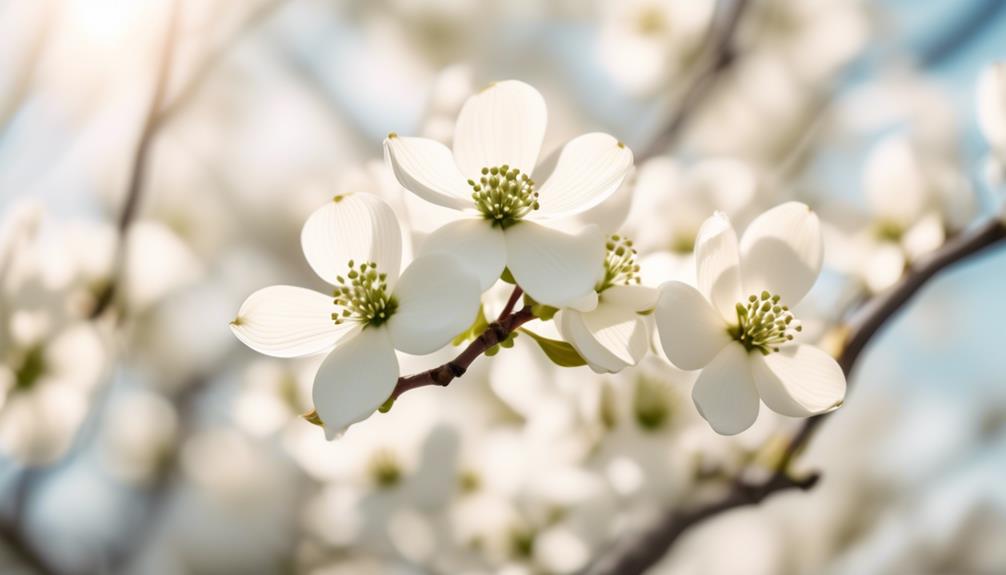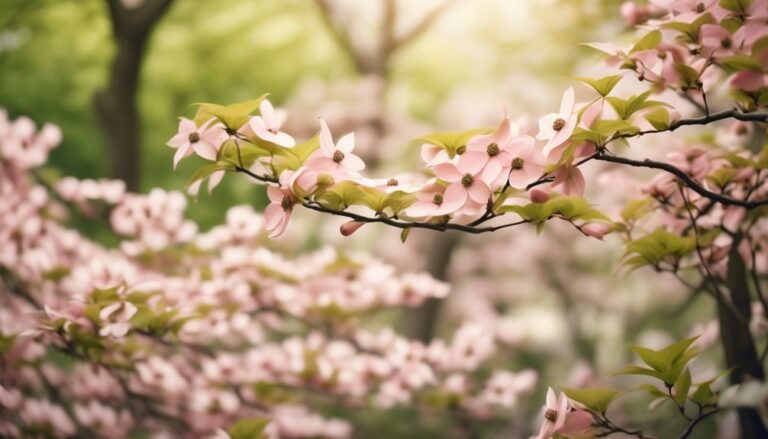The Symbolism and Meanings of Dogwood Flowers
As you stroll through a garden or catch a glimpse of a dogwood flower in bloom, you may not realize the deeper meanings that lie within its delicate petals. These flowers, like secrets waiting to be uncovered, hold a wealth of symbolism and significance.
From religious connotations to expressions of purity and love, the dogwood flower invites you to unravel its mysteries and discover the hidden stories it has to tell.
So, take a moment to pause and ponder, for within the realm of the dogwood flower, a world of meaning awaits.
Historical Significance
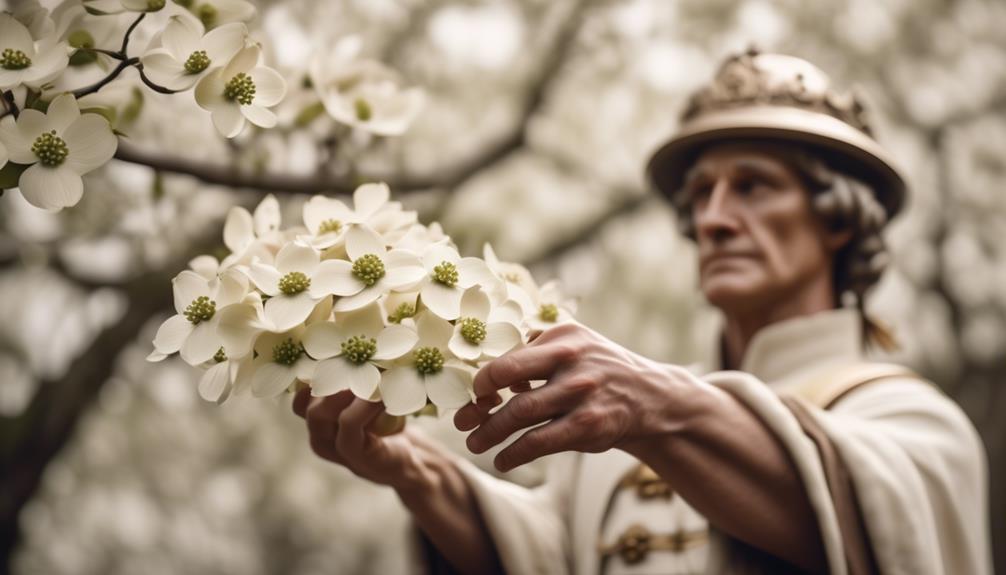
The historical significance of dogwood flowers is rooted in the legend of the dogwood tree, which attributes its wood to the cross of Jesus's crucifixion. According to the legend, Jesus cursed the dogwood tree, causing it to become small and crooked, symbolizing the Crucifixion. While there's no evidence to support this legend, it holds subjective importance and is linked to the belief that dogwoods bloom around Easter, symbolizing Jesus' resurrection.
The dogwood tree's historical significance includes its association with Jesus' crucifixion, its valued wood, and its symbolism of rebirth and renewal in Christianity. The dogwood flower, with its white bracts forming a cross and red markings, represents the Crucifixion and the blood of Jesus, contributing to its historical and religious significance.
Cultural Symbolism
Culturally, dogwood flowers hold significant symbolism and meanings that have been passed down through generations. Here are some interesting facts about the cultural symbolism of dogwood flowers:
- The legend of the dogwood tree claims that the cross of Jesus's crucifixion was made of dogwood. The white part of the dogwood flower, which is actually leaves called bracts, forms a cross shape symbolizing the crucifixion of Jesus.
- The legend of the dogwood tree is unverified and likely originated from a 20th-century poem.
- Flowering dogwood trees are the state tree of Virginia, Missouri, and the state flower of North Carolina.
- Dogwood trees symbolize rebirth, purity, strength, and resilience, particularly in Christianity.
- Dogwood flowers typically come in different colors, including white flowers with rusty red spots, and are often used in floral arrangements to symbolize beauty and grace.
These cultural associations and meanings make dogwood flowers a cherished and significant symbol in various traditions and practices.
Religious Meanings
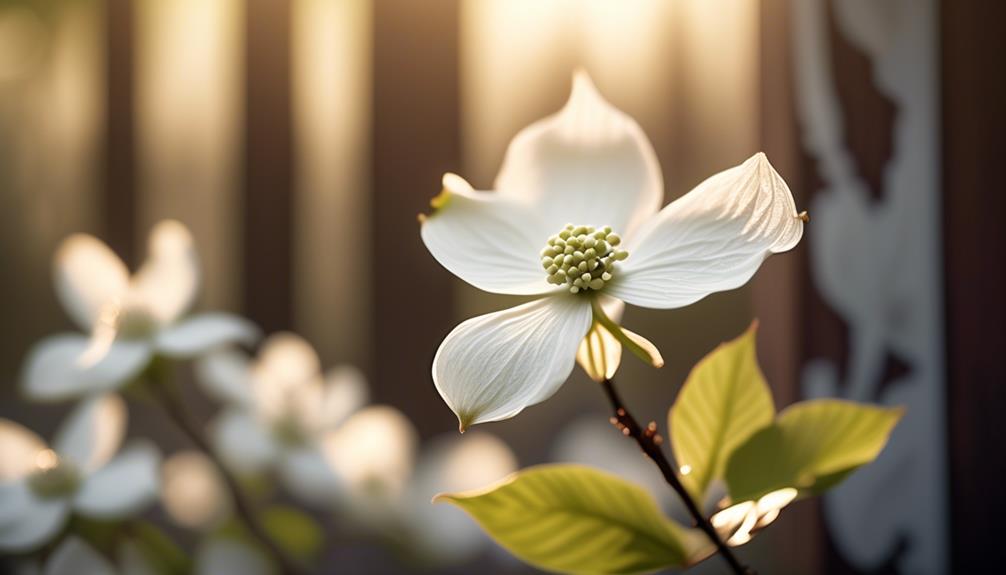
As we shift our focus to the religious meanings associated with dogwood flowers, let's explore their significance in Christian beliefs.
In Christianity, the dogwood flower holds great spiritual symbolism. According to legend, the wood of the dogwood tree was used to make the cross that Jesus was crucified on. The shape of the dogwood flower's bracts forms a cross, representing the crucifixion of Jesus. The indented edge of the bracts resembles nails, symbolizing the nails that were driven into Jesus's hands and feet. Some dogwood flowers also have red marks around the bracts, symbolizing the blood of Jesus.
Christians believe that the dogwood flower serves as a reminder of Jesus's sacrifice and represents the spiritual concepts of rebirth and renewal. The dogwood flower's religious meanings reflect the deep-rooted faith and devotion of Christian believers.
Color Symbolism
Symbolizing various emotions and concepts, the colors of dogwood flowers hold significant meaning and depth. The color symbolism of dogwood flowers includes:
- White flowering dogwood: Represents purity, renewal, and rebirth. It's often connected to Christianity, symbolizing the resurrection of Jesus.
- Pink and dark red dogwood varieties: Symbolize love and passion, adding a touch of romance to any garden or landscape.
- The white part of the dogwood flower (bracts): Forms a cross shape, representing the crucifixion of Jesus.
- Red marks around the bracts: Represent the blood of Jesus in some dogwood flowers, adding a religious significance to their appearance.
- The red fruit of dogwood trees: Signifies strength and resilience, as it's a common flowering tree that can withstand harsh conditions.
Understanding the color symbolism of dogwood blooms can help you appreciate their beauty and deeper meanings. Whether you're making a specific decision for your garden or simply admiring the currently growing dogwood flowers, their colors add another layer of significance to these remarkable plants.
Botanical Characteristics
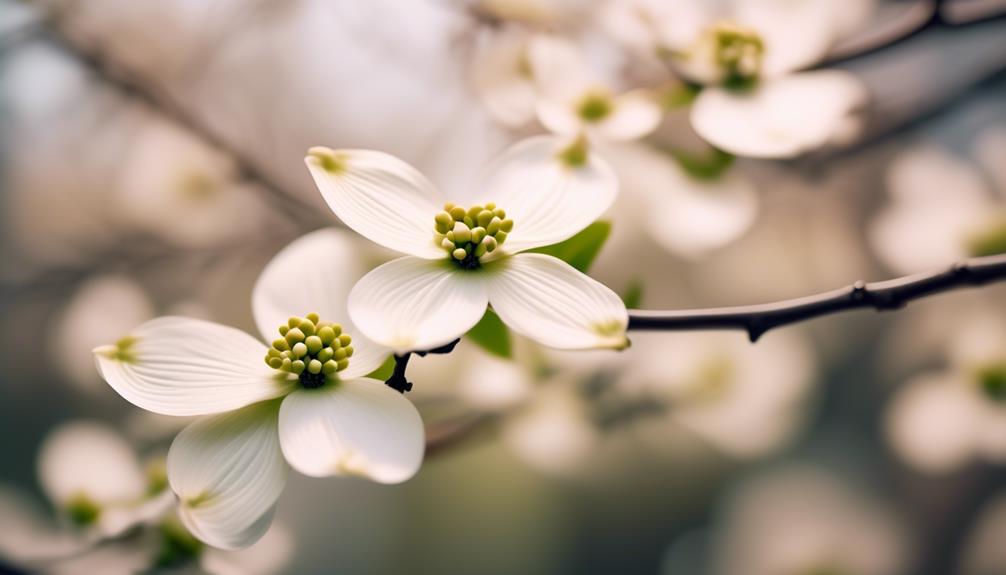
Now let's explore the botanical characteristics of dogwood flowers, shedding light on their unique features and structure.
Dogwood flowers, a symbol of love and purity, are native to North America. They produce red fruit, adding to their beauty and symbolism. These flowers grow tall enough to be admired, often reaching heights of 20 to 30 feet.
Dogwood flowers are known for their religious symbolism, particularly in the Christian faith. In fact, their common name, 'dogwood,' is derived from 'dagwood,' which refers to the crucifixion of Jesus.
The structure of dogwood flowers is fascinating, with four bracts that form a cross shape, representing the crucifixion. The bracts have an indented edge, resembling a nail passing through them.
These botanical characteristics make dogwood flowers truly special and meaningful.
Conclusion
In conclusion, dogwood flowers hold deep religious and symbolic meanings, particularly in Christianity. They represent rebirth, resurrection, and the crucifixion of Jesus. The four bracts forming a cross shape and the red marks symbolize the nail and blood of Jesus.
Dogwood flowers also symbolize purity, durability, and strength, with white flowers representing purity and pink and dark red flowers symbolizing love and passion.
With their rich history and cultural significance, dogwood flowers continue to hold a special place in our hearts.

